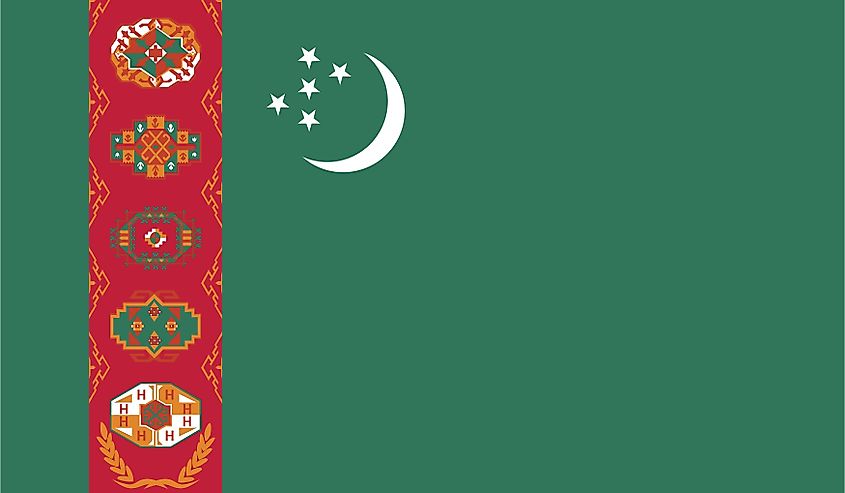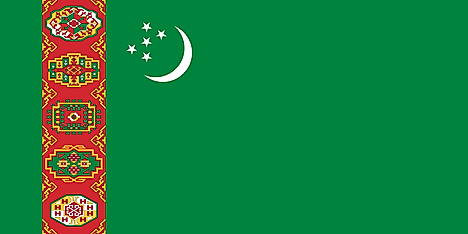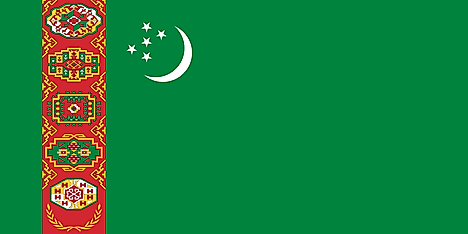
The National Flag of Turkmenistan was officially adopted on January 24, 2001.
The National Flag of Turkmenistan features a green field with a red stripe placed vertically towards the hoist side of the flag. The stripe features five carpet guls (medallion-shaped design elements of traditional carpets from the Central Asian region). At the bottom of these guls are two olive branches crossing each other at the base. A waxing crescent moon and five stars are located in the upper part of the green field, on the fly side of the red stripe. The moon and stars are white in color, and each of the five stars have five points. The red and the green colors featured on the flag have historically been highly revered by the people of Turkmenistan. The green color and crescent moon represent Islam. The five carpet guls represent the country’s five major tribes: Teke, Yomut, Saryk, Chowdur, and Arsary. The wreath symbolizes Turkmenistan’s “status of permanent neutrality.” The guls reflect the national identity of Turkmenistan where carpet-making has long been a part of traditional nomadic life. The waxing moon is a symbol of the hope of a bright future of Turkmenistan, and the five stars represent the regions or welayats of Turkmenistan. The flag has a width-to-length ratio of 2:3.
History of the Flag of Turkmenistan
The Russian Empire’s flag was long regarded as the official flag of Turkmenistan. However, after the Russian Revolution and the fall of the Empire, Turkmenistan adopted a flag similar in design to other Soviet Republics. Following the collapse of the Soviet Union, Turkmenistan gained independence in 1991 and adopted a new flag on February 19, 1992. The design of the new flag closely resembled that used in Turkmenistan today. In 1997, an olive branch symbolizing the peace-loving nature of the Turkmen was added to the flag, as well as some additional changes. Finally, in 2001, the flag’s green color was made lighter and its official dimensions were changed from 1:2 to 2:3.
Symbols of Turkmenistan
The National Coat of Arms of Turkmenistan
The National Coat of Arms/Emblem of Turkmenistan is composed of a golden edged eight-pointed green star (the Rub El Hizb) and displays an Akhal-Teke horse centered in a blue disc. The Rub El Hizb is considered to be a symbol of Islam and the Akhal-Teke horse signifies a source of pride for the people of Turkmenistan. Surrounding the horse, on a band of red, are five traditional carpet motifs (representing the Teke, Yomut, Arsary, Chowdur and Saryk tribes). Sheaves of wheat and seven flowers make up the outer edge with the symbol of Islam (crescent and stars) resting above.
National Motto
“Independence, Neutrality, Stability!”
National Anthem
- Anthem Title: Garaşsyz, Bitarap Türkmenistanyň Döwlet Gimni (” National Anthem of Independent, Neutral Turkmenistan”)
- Music Composer: Veli Mukhatov
- Lyricist: Collectively
- Date of Adoption: 2008
Garaşsyz, Bitarap Türkmenistanyň Döwlet Gimni (” National Anthem of Independent, Neutral Turkmenistan”) is the national anthem of Turkmenistan. The music of the anthem have been composed by Veli Mukhatov. Thye lyrics have been authored collectively by a group of people. The anthem was officially adopted in 2008.
Garaşsyz, Bitarap Türkmenistanyň Döwlet Gimni (Latin)
1.
Janym gurban saňa, erkana ýurdum
Mert pederleň ruhy bardyr könülde.
Bitarap, Garaşsyz topragyň nurdur
Baýdagyň belentdir dünýän önünde.
Gaýtalama:
Halkyň guran baky beýik binasy
Berkarar döwletim, jigerim–janym.
Başlaryň täji sen, diller senasy
Dünýä dursun, sen dur, Türkmenistanym!
2.
Gardaşdyr tireler, amandyr iller
Owal–ahyr birdir bizin ganymyz.
Harasatlar almaz, syndyrmaz siller
Nesiller döş gerip gorar şanymyz.
Gaýtalama:
“National Anthem of Independent, Neutral Turkmenistan”
1.
I am ready to give life for our native hearth
The spirit of ancestors descendants are famous for.
My land is sacred, my flag flies in the world
A symbol of the great neutral country flies,
Chorus:
The forever great creation of the people
The native land, the sovereign state
Forever, the light and song of the soul,
Long live and prosper, Turkmenistan!
2.
My nation is united and in veins of tribes
Our ancestors’ blood, undying flows.
Storms and misfortunes of times are not dreadful for us,
Let us increase fame and honour.
Chorus:
The Currency of Turkmenistan is the Turkmenistan Manat
The current official currency of Turkmenistan is the Turkmenistan Manat (TMT). The term “manat” is borrowed from a Russian word “moneta,” which was used to refer to the Soviet ruble. The Central Bank of Turkmenistan is in charge of issuance and circulation of the currency.
Coins
Currently, coins in denominations of 1, 2, 5, 10, 20, 50 tenge and 1, 2 manat are in circulation.
The first manat coins were introduced in 1993 in several denominations, including 1, 5, 10, 20, and 50 tenges. The coins were struck in copper-plated steel and nickel-plated steel. The coins did not last long, since their metal value was worth more than their actual value. After the high inflation in 1999, coins of higher denominations were introduced, including 500 and 1,000 manats. The new coins depicted the portrait of the president, as was required by the law. The monetary reform of 2009 led to the introduction of new coins in the old denominations issued in 1993. In 2010, bi-metallic 1 and 2 manat coins were issued. Instead of the portrait of the president, the current coins depict the map of Turkmenistan with the Independence Tower imposed on it.
Banknotes
Currently, banknotes in denominations of 1, 5, 10, 20, 50, 100, 500 manat are in circulation.
The first manat banknotes were also introduced in 1993, alongside the coins, in denominations ranging from 1 to 500 manat. In 1995, the 1000 manat note was introduced, followed by 5,000 and 10,000 notes in 1996. A new series of banknotes was issued in 2005 to replace the old notes. After the high inflation which devalued the currency, the new manat was introduced to replace the old manat at an exchange rate of one new manat for 5000 old manats. New banknotes were printed in denominations ranging from 1 to 500 new manat. However, the 500 new manat has not been released into circulation. The banknotes feature several buildings and portraits of monumental leaders important in the history of Turkmenistan.
Historical currencies of Turkmenistan
The old Turkmenistan manat was introduced in November 1993 as a replacement for the Russian ruble, at an exchange rate of 1 manat for 500 rubles. The introduction of the manat marked the final break away from the Soviet Union. The currency was symbolized by TMM and was sub-divided into 100 tenges. The high rate of inflation in the country was the main reason for the replacement of the old manat with the new manat. The new Turkmenistan manat was introduced on January 1, 2009, with an ISO 4217 code TMT, at an exchange rate of 5000 old manats for every one new manat.










